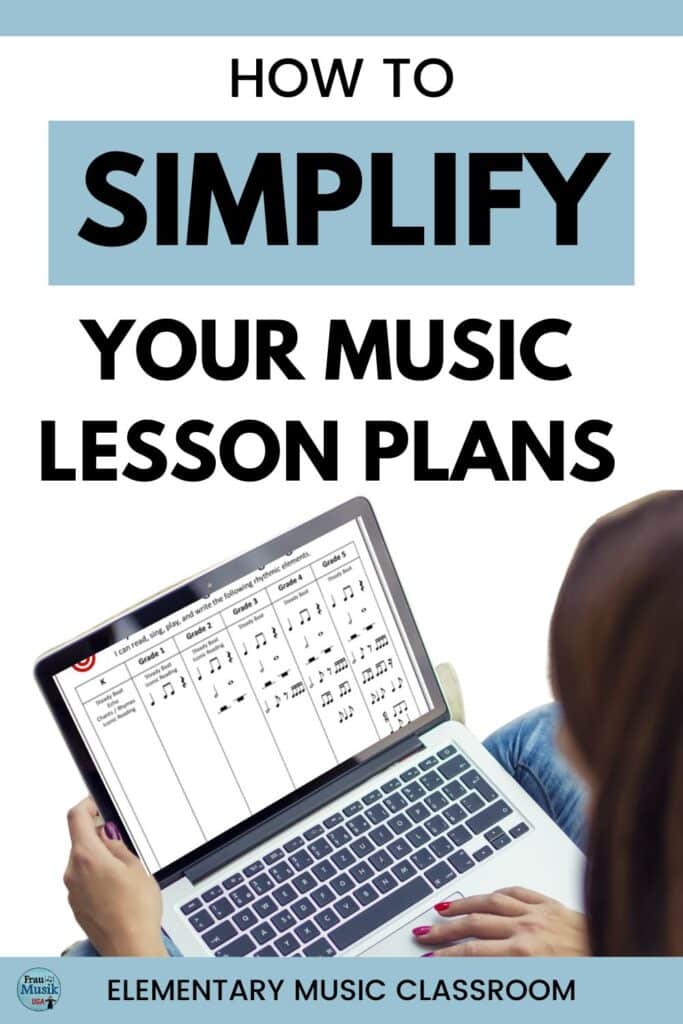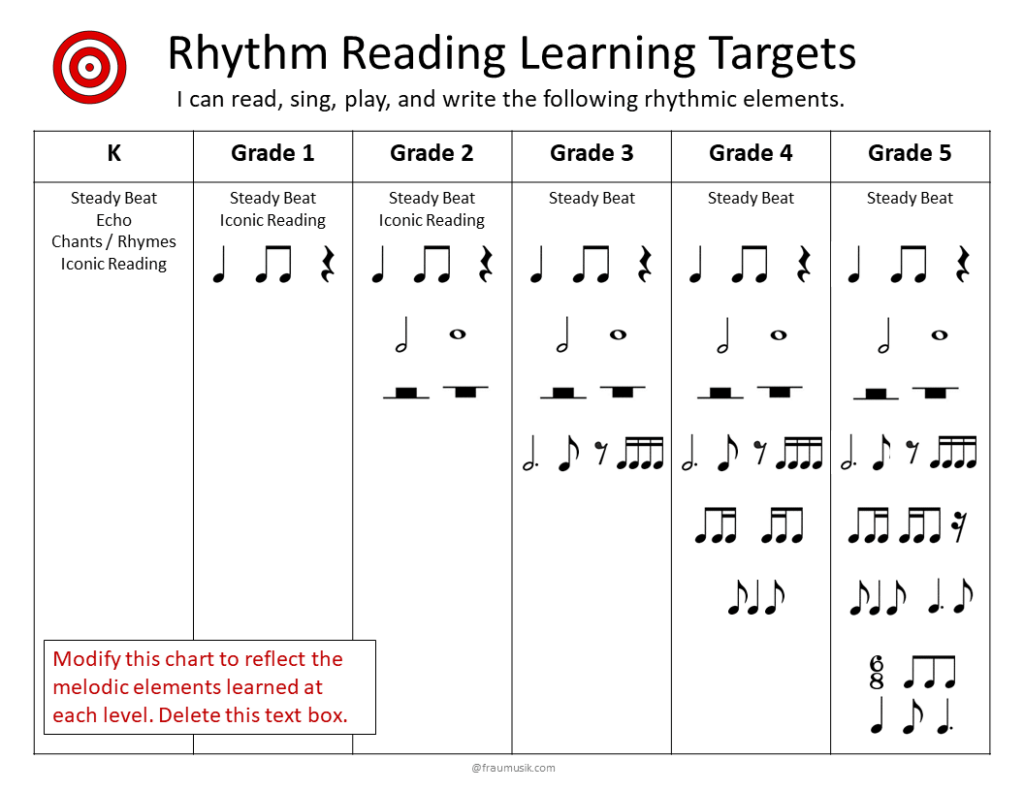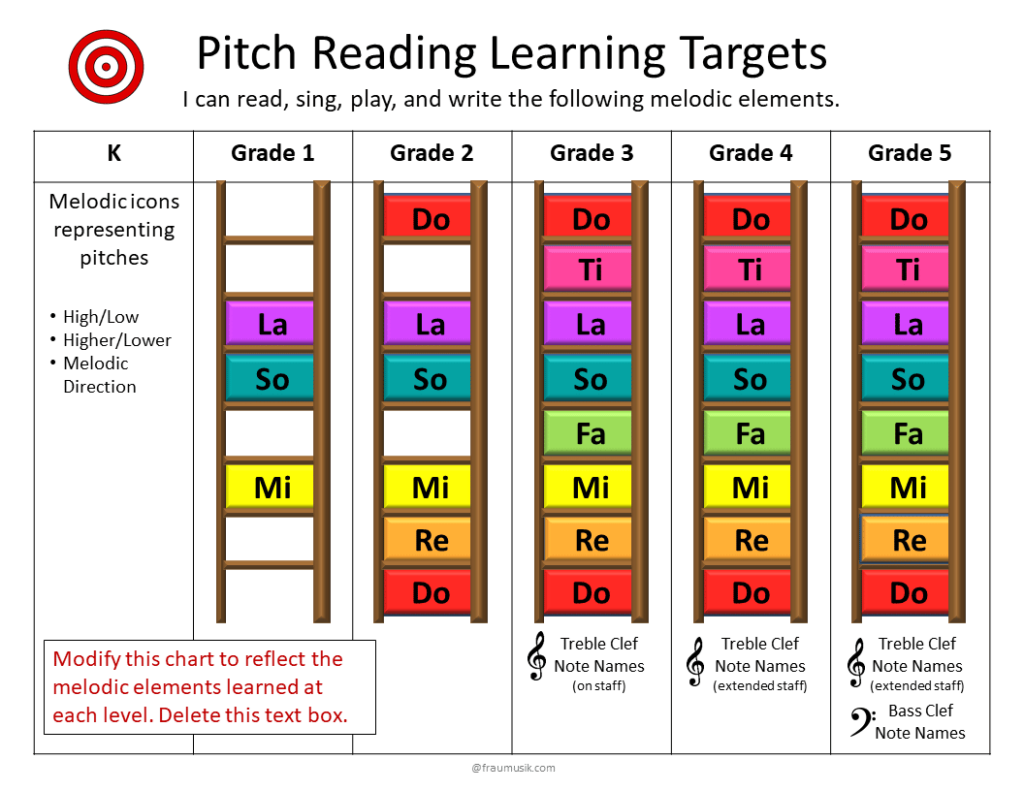Simplify Elementary Music Lesson Plans with FREE Yearly Planning Charts
Creating weekly lesson plans can be exhausting. Check out these tips to simplify your elementary music curriculum and make lesson planning a breeze.
Some of the links on our site are affiliate links. If you click on a link and make a purchase, we may earn a small commission.
Our school used to have an elementary music curriculum that was incredibly detailed, outlining the specific music elements that students should learn at each grade level. But it was over a hundred pages long, wordy, and difficult to use.
The current curriculum is completely different. It is much shorter, which is good. But it is very general and vague. A beginning teacher will not have much guidance from this document. And, since there are 11 elementary schools in our district, students who transfer from one school to another may find themselves unprepared for the activities in their new music classroom.

The ideal music curriculum probably lies somewhere in between these two documents. Below are some tips to simplify and clarify your elementary music curriculum, which will ultimately make your weekly and daily lesson planning easier and create more efficient and effective classroom lessons.
What’s in this post? Click to open the Table of Contents
Create Simplified Charts of Your Elementary Music Curriculum
To provide an overview of our comprehensive curriculum, I created two concise charts that summarize the key music literacy elements taught at each grade level. These charts serve as a streamlined representation, focusing specifically on the fundamental rhythmic and melodic components.
To help you get a jumpstart on your yearly planning, I have created these FREE Elementary Music Yearly Planning Charts. They are 100% EDITABLE so that you may customize them to match your elementary music curriculum. And, best of all we will send them directly to your inbox when you sign up for our free helpful elementary music teacher email list.
More Ways to Use These Charts
These rhythmic and melodic learning target charts may be used in a variety of ways.
- Print them as classroom posters to display learning targets for students.
- Distribute the charts as handouts to parents during open house or parent-teacher conferences.
- Add the charts to your planner as a reference guide for planning monthly, weekly, and daily lesson plans.
- Include the charts in student portfolios to track progress and showcase achievements.
Create a Monthly Scope and Sequence
Once you have completed your yearly charts, the next step is to develop a monthly scope and sequence for each grade level. The first time you design a monthly plan, it can seem overwhelming. But in subsequent years, it usually only involves making minor modifications which is much easier than starting from scratch.
Modifying an existing document is always easier than creating a new one, which is where our elementary music literacy Scope and Sequence Planning Charts come in handy. These charts provide a solid foundation for your monthly planning needs and they are 100% editable.
If you are new to monthly planning, don’t worry about perfection; make educated guesses and refine your plan as you progress throughout the year. Having monthly plans allows you to easily create weekly and daily lesson plans which are more coherent and build upon one another.
Having yearly and monthly charts in place is the key to simplifying your elementary music curriculum and helping make your weekly/daily lesson plans more coherent and easier to create.
Integrate Other Music Elements Naturally through Performance Skills
To guide students to become musically literate and sensitive performers, it’s essential to incorporate additional musical elements and performance skills beyond rhythm and pitch reading. Ensure that the following components are integrated into your monthly scope and sequence in a manner that makes the most sense.
- Tone/Timbre
- Diction
- Dynamics
- Tempo
- Phrasing
- Articulations
- Form
- Meter
- Improvisation
- Composition
- Instruments of the Orchestra/Band
When you integrate other musical elements and activities into your lessons while using the same songs, you not only maintain the freshness of these music literacy songs but also teach other elements in an authentic and applicable manner.
Are you looking for even more opportunities to multitask and be efficient? Vocal Solfege Warm Ups provide another short, simple way to teach and reinforce music literacy and performance skills at the same time.
Allow Plenty of Time to Practice and Learn Music Concepts
As you develop your monthly sequence, keep the following guidelines in mind.
- Be realistic and set an attainable timetable. Schedule grade-level performances into your monthly charts.
- Build in review. This is especially important if you frequently get new students.
- Teach and practice each music literacy song multiple times. Avoid treating them as “one and done” lessons.
- Keep songs fresh by adding different activities during each class session such as games, movement, Orff instrumental patterns, harmony parts, etc.
- Reinforce the same music elements using multiple songs and activities to solidify learning.
It’s important not to rush the learning process. Help students develop and internalize music concepts by giving them ample opportunities to practice singing, playing, reading, and “writing” the same musical elements in a variety of ways.
Creating Weekly and Daily Lesson Plans
As you follow the sequence outlined in your monthly charts, you can easily plug in songs and activities that teach music literacy in a sequential way. Choose activities that have worked well for you in the past and toss or revamp those that have not gone well. Then, look for new songs, resources, and activities to fill in the gaps.
It can be tricky to find the perfect song or activity to teach each specific music literacy element. However, you can make it easier by using this free and easy-to-use Elementary Music Literacy Resource Guide. The guide includes a detailed index of music elements, making it simple to find the ideal activities to fit your students’ needs. You’ll find MANY FREE resources as well as helpful paid resources in this helpful “at-a-glance” index.
“Everything Relates to Everything”
This is a frequent saying of one of my favorite college professors. And, she is right! Teaching music reading, technique, performance skills, and music creation and composition is all interrelated.
When you use yearly and monthly planning charts, you can easily organize your elementary music curriculum and develop coherent activities that build upon prior learning. This will allow you to create more sequential, effective, and efficient music lesson plans and save your precious time.
Everything does relate to everything.
💡 Don’t forget to subscribe to our helpful email list and pick up these Editable Elementary Music Yearly Planning Charts sent directly to your inbox.
Hope to see you soon!
Meet the Author
Terri Lloyd is a former elementary music teacher with over 25 years of experience. She holds a Bachelor of Music, a Master of Science in Education, and a Technology Certificate in Instructional Design.
She is currently active in music education through blogging, workshops, and curriculum development. She serves on the music staff at her church and volunteers for an after-school children’s program. Terri is an active musician in the community, performing in a local Big Band, pit orchestras, and various events.
Helpful Planning Resources
- 9 Summer Lesson Planning Tips for Elementary Music Teachers
- FREE Elementary Music Yearly Planning Charts
- Monthly Music Literacy Scope and Sequence Planning Charts
- FREE Elementary Music Literacy Resource Guide


2 Comments
Comments are closed.